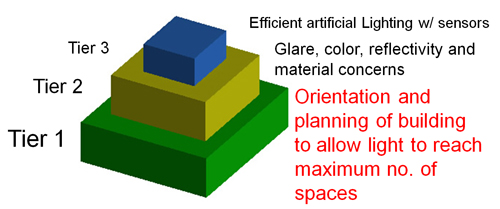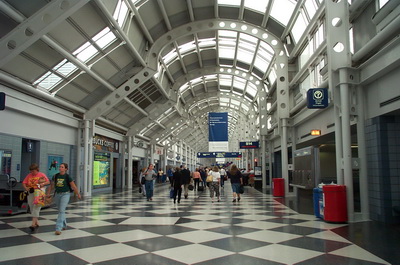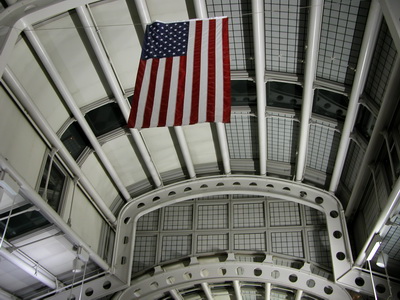#1 - REDUCE LOADS / DEMAND FIRST - Daylighting
DIFFERENTIATING BETWEEN SUNLIGHT AND DAYLIGHT:
It is imperative that a distinction is clearly drawn between the modifications in the building design to use the sun for passive solar heating, and those required to light the building naturally. Passive solar heating requires that direct beam radiation enter the building in order for the effective transfer of heat energy to interior thermal mass. Daylighting strategies prefer diffuse or indirect light as it provides a more even amount of light in the room, and obviates many associated issues of glare and visual discomfort. Additionally, where passive heating is a priority during the cold months, daylighting is of concern year round. Strategies must therefore be developed for the building envelope and massing that provide the maximum amount of daylighting for the entire year.
Daylighting is environmentally advantageous because it:
-
reduces the need for electric lighting (hours of operation), therefore
-
reducing the energy needed to power the lights, therefore
-
reducing the heat generated from the lights, thereby
-
reducing the cooling required for the space
This has a net benefit to a Carbon Neutral building as it impacts both the lighting and cooling requirements for energy.
Other proven social/health benefits of daylighting:
-
improves productivity and worker well being this has been translated into a reduction in sick days, which has saved some companies hundreds of thousands of dollars
-
increased education in children: daylit schools have been proven to assist in higher levels of achievement and a decrease in dental problems!
-
daylighting is also worth 2 basic LEED® credits in the Interior Environmental Quality category
Unlike electric lighting, the total available light is fixed (in this case the worst-case Design Sky Illuminance), thus control over the amount of light is possible only by changing the means of transmission into the space through its apertures, and then to points deeper within the space by its distribution system. This means that architectural elements such as windows, skylights, lightshelves and even the reflectivity of internal surfaces are very important factors in daylighting design. So too are external elements such as site obstructions and applied shading devices.
THE TIERED APPROACH TO DAYLIGHTING:
A tiered approach to daylighting is also a useful way to begin to maximize the number of spaces in the building that can primarily rely on daylighting for daytime illumination, and therefore reduce the ultimate need for electric lighting. Even though systems for electric lighting will still need to be in place, the operating energy can be greatly reduced if the number of daytime hours in which lighting is not turned on at all can be increased.

The Tiered Approach to Daylighting (after Lechner)
Orientation, Planning and Building Orientation:
- start with solar geometry understand context, sky dome, adjacent buildings and potential overshadowing
- be able to differentiate between sunlight (heat) and daylight (seeing)
- understand occupancy/use requirements
- maximize areas served by daylight
- explore different glazing strategies: side, clerestory, top
- consider light shelves and reflected light
Glare, Color, Reflectivity and Material Concerns:
- incorporate light dynamics
- avoid glare
- understand the function of material selection; ie. reflectivity and surface qualities
- balance color and reflectivity with amount of daylight provided
Effective and Efficient Lighting:
- use energy efficient light fixtures (and effectively!)
-
use occupant sensors combined with light level sensors aim to only have lights switch on only when daylight is insufficient
-
provide electricity via renewable means: wind, PV, CHP, or via local Green Power


OHare Airport, as is typical of many such facilities, makes extensive use of daylight as the primary source of illumination during the daytiime hours. The use of frit in the glass, which controls unwanted solar gain during the daytime, provides for a reflective surface assisting in achieving reasonable artificial lighting levels during the evening hours. |
BALANCING LIGHTING AND THERMAL ENVELOPE REQUIREMENTS:
Generally speaking, the R-value of walls is 7 times that of walls designed for cold climate construction, and the R-value of roofs is close to 19 times that of most commercial skylights. Carbon Neutral envelopes that are desiged for cool to cold climates are increasing their R-values to almost twice current code. This makes the disparity between oEven if high performance glazing and frames have been selected, windows and skylights present significant concern when accounting for heat losses. When the heat has been provided passively and is in finite supply, this is of even greater concern.
When designing for daylighting, it will be important to run computer simulations to ensure that a good balance of heating and lighting priorities have been addressed in the solution. Smaller window openings can provide effective daylight if their distribution, orientation, sill and head height are considered, as well as the reflectivity that can be provided by both exterior and interior surfaces. Room height and depth are also critical if light is to be bounced to the rear from either light shelves or the ceiling. Floor to ceiling glass is not necessary to ensure adequate daylighting and will likely lead to significant problems on the heating side of the equation - negating many of the potential carbon reduction benefits.
ESSAY ON CARBON NEUTRAL DAYLIGHTING DESIGN BY MARY GUZOWSKI, UNIVERSITY OF MINNESOTA, AUTHOR OF "DAYLIGHTING FOR SUSTAINABLE DESIGN".

HELPFUL LINKS IN THE AIA 50to50 WIKI:
Daylighting
Open, Active, Daylit Spaces
Sun Shading
Other Helpful Links:
The Square One Website Archive has some very good instructional information on Lighting Design, Illumination and Daylighting.
http://www.squ1.com/archive/
Whole Building Design Guide: Daylighting
http://www.wbdg.org/resources/daylighting.php
The Daylighting Guide for Canadian Commercial Buildings:
http://www.enermodal.com/Canadian/pdf/DaylightingGuideforCanadianBuildingsFinal6.pdf
Daylighting: Ecotect WIKI
http://squ1.org/wiki/Daylighting
Tips for Daylighting: Lawrence Berkeley Labs
http://www.architecture.uwaterloo.ca/faculty_projects/terri/powerpoint/daylighting_guide.pdf
HIGHLY RECOMMENDED TEXTS FOR DAYLIGHTING (written by SBSE members!):
Daylighting for Sustainable Design. Mary Guzowski.
Heating, Cooling, Lighting: Sustainable Design Methods for Architects. Third Edition. Norbert Lechner.
Mechanical and Electrical Equipment for Buildings. Benjamin Stein, John Reynolds, Walter Grondzik, Alison Kwok.
Sun, Wind and Light: Architectural Design Strategies. Second Edition. G. Z. Brown and Mark DeKay.
The Green Studio Handbook: Environmental Strategies for Schematic Design. Walter Grondzik and Alison Kwok.
|

